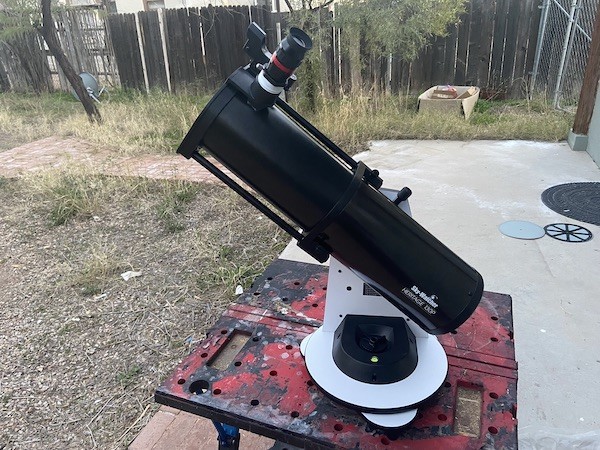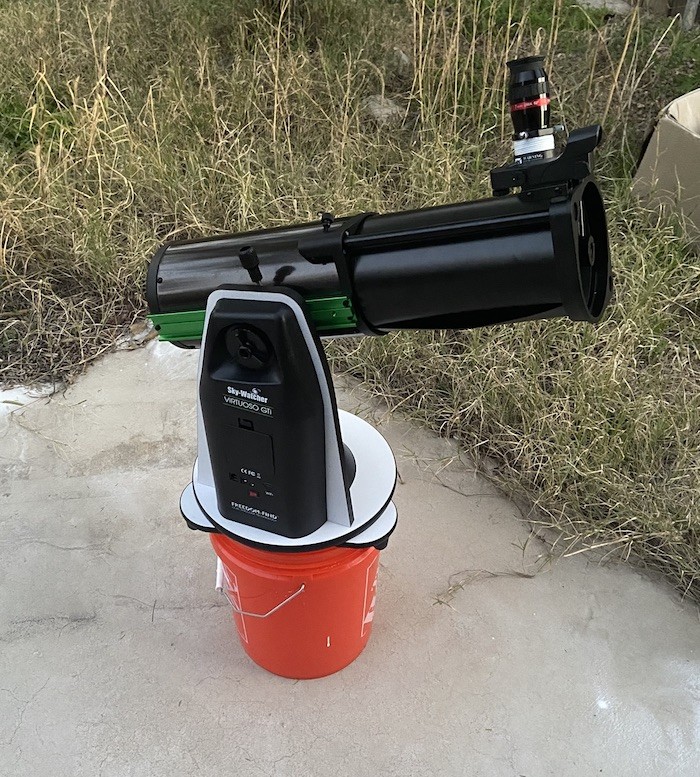The Optical Tube

The Sky-Watcher Virtuoso GTi 130P is a 5.1” (130mm) f/5 Newtonian reflector with a focal length of 650mm.
The Virtuoso GTi 130P shares its optical configuration with many other 130mm f/5s, including the SkyWatcher’s Heritage 130P and 130PDS astrographs and Celestron’s many 130mm f/5 computerized Newtonians, among others.
An f/5 Newtonian shows minor coma at low magnification at the edges of the field of view with a wide-angle 2” ocular (or if you look really hard at the edge of the field with a 1.25” eyepiece). But given the 130P’s 1.25″-only focuser, you’re probably never going to notice anyway. However, many cheap wide-angle eyepieces will show similar-looking aberrations at the edge of the field in an f/5 Newtonian, so keep this in mind when shopping for extra eyepieces.
RECOMMENDED BUY FOR THE COLLAPSIBLE TUBE
The Heritage and Virtuoso are different from the other 130mm f/5 scopes because they have collapsible strut tubes. The tube of the Virtuoso GTi 130P can be collapsed in half to make it easier to store and move. This allows it to fit in a large backpack, padded case, or suitcase for the purpose of traveling with the telescope and also makes it small enough to fit inside a cabinet or under a bed if need be for storage.
Buy Virtuoso GTi 130P from HighPointAs with any Newtonian reflector, regular collimation of the 130P is required to achieve sharp images, though it’s nothing to be scared of—see our collimation guide for more info.
The open tube of the Virtuoso GTi 130P necessitates some kind of shroud to keep light, dew, dust, and insects out of the tube. Without one, if you have any kind of light pollution (let alone local direct light shining into the tube), the view will be washed out in brown.
Sky-Watcher doesn’t sell a shroud, but making one out of foam takes just a few minutes. The plastic baffle across from the 130P’s focuser is enough to prevent the worst contrast loss under moderately dark skies, provided you’re far away from direct light sources. But making a shroud is just a good idea anyway and will keep your optics better protected during use.
While the 1.25” helical focuser is plastic, I’ve found it to be working fine as long as I don’t overload it with super-heavy eyepieces. I couldn’t install a rack-and-pinion or Crayford focuser on the 130P optical tube, as it is too heavy for the struts to handle, which results in tipping the telescope over with its mass. However, unless you already have better focusers or eyepieces in your collection, they are going to cost as much as the Virtuoso GTi 130P itself. So, I don’t see the lightweight helical focuser as a problem for most of the GTi 130P’s target audience.
As with many telescopes, the Virtuoso GTi 130P attaches the tube and mount together with a Vixen-style dovetail rail and clamp. Technically, this means I could put the GTi 130P on another mount, but this mostly results in the eyepiece being in an uncomfortable viewing position. Astrophotography with a DSLR or similar would put too much strain on the 130P’s helical focuser and strut tube, anyway.
Accessories
The Sky-Watcher Virtuoso GTi 130P comes with Sky-Watcher’s standard 25mm and 10mm 1.25″ “Super” eyepieces. The 25mm eyepiece has a magnification of 26x, and the 10mm eyepiece has a magnification of 65x.
RECOMMENDED BUY FOR THE EYEPIECES PROVIDED
The eyepieces are both nice and are based on the Konig design, with glass optics, though the exterior of each is all plastic. They are wide-angle, long eye relief designs based on the Konig type, providing a 55-degree apparent field of view with decent sharpness out to the edge. Unlike a Plossl or Kellner, the 10mm Super is quite comfortable to look through without jamming my eye into it, as the Super Konig design has longer eye relief than a Kellner, Plossl, or Orthoscopic eyepiece would at this focal length.
Buy Virtuoso GTi 130P from HighPointYou’ll almost certainly want additional eyepieces for higher magnifications. Good planetary views are usually found at 100x magnification or above, and the 130P can handle up to around 200x before you hit the limits of its resolving power.
The finder is a standard red dot finder, which is more than enough for aiming the GTi 130P around the sky, either for a star alignment for GoTo or purely manually.
Tabletop Mount
The Sky-Watcher Virtuoso GTi 130P’s tabletop mount is based on the Heritage 130P mount, with the addition of motor drives and clutches on both axes.
RECOMMENDED BUY FOR THE MANUAL TO COMPUTERIZED SWITCHING
The clutches can be unlocked to allow you to aim the GTi 130P manually, just like a regular tabletop Dobsonian. Or you can tighten them and power on the mount to use it in computerized mode. Even if you switch to-and-fro between the manual and the GoTo system, it won’t affect the alignment or the tracking. Sky-Watcher has branded this dual encoder technology as their “FreedomFind” technology, and it is now present on the majority of their products.
Buy Virtuoso GTi 130P from HighPointThe mount runs on a small pack of batteries, or you can do as I did: get a rechargeable power supply and plug it in. You control it via your smartphone or tablet over the mount’s built-in WiFi network with either the free SkyWatcher SynScan app or another astronomy app like SkySafari Pro or Stellarium. The GTi 130P will then slew around the sky to tens of thousands of possible targets at the push of a button and automatically track the target no matter what you are aiming at.
The Virtuoso GTi 130P needs a very sturdy tabletop surface, both for viewing comfort and to keep the GoTo system aligned. Trying to manually aim the scope on a shaky table is already frustrating. It will also mess up the accuracy of the motors and make for a very frustrating experience. A bar stool or milk crate works well for standing or seated use, respectively, or you can build a stand yourself for the 130P or any other tabletop telescope with some basic carpentry tools and materials for relatively little money.

Should I buy a used Sky-Watcher Virtuoso GTi 130P?
A used SkyWatcher Virtuoso GTi 130P in a poor condition would be an unusual find, as these telescopes only started being available for purchase in 2022. The main things to watch out for are any issues with the electronics or mirror coatings, which would probably make purchasing a used unit a no-go. Small dents in the tube that don’t get in the way of the light aren’t a problem, and it’s usually not too hard to get rid of big ones with an automotive dent puller.
Alternative Recommendations
The Sky-Watcher Virtuoso GTi 130P isn’t my top pick in its price range, mainly because the Virtuoso GTi 150P costs just a bit more and has significantly more aperture with otherwise the same features. However, there are some non-GoTo manual telescopes as alternatives:
- The manual Heritage 150P and Heritage 130 are obviously our first picks as alternatives; they are identical to the Virtuoso GTi 150P and 130P, respectively, apart from lacking all the electronics (the GoTo system).
- A free-standing 6” f/8 Dobsonian like the Apertura AD6 is easier to collimate than a fast tabletop scope like the Virtuoso GTi 130P, and you, of course, don’t need to worry about a table or stand anymore, but a 6” f/8 will have a significantly narrower field of view than a 4-6” f/4 to f/5 telescope.
Check out our rankings and top picks pages for more information.
Aftermarket Accessory Recommendations
The Virtuoso GTi 130P can handle up to 200–250x magnification or so with its 5.1” aperture and sharp optics, but 150–200x is all you’re actually going to benefit from. There are diminishing returns to going higher. The oft-cited 6mm “redline” or “goldline” eyepiece provides 108x with the 130P, and a 4mm planetary eyepiece will provide 163x magnification. Higher power is best for seeing planets, globular star clusters, or planetary nebulae and splitting close double or triple stars.
A narrowband, ultra-high-contrast (UHC) nebula filter is a bit pricey, but it will make it much easier to see nebulae through the Virtuoso GTi 130P or any other telescope, whether the sky is filled with light or not. A UHC filter doesn’t make light pollution go away, nor can any other filter or device, but it will mitigate the effects of light pollution on most nebulae and enhance contrast under any conditions.
What can you see with the Virtuoso GTi 130P?
The 130mm (5.1”) aperture of the Sky-Watcher Virtuoso GTi 130P does a pretty good job on the Moon and planets. You’ll be able to resolve thousands of craters, mountains, and ridges on the lunar surface mere miles in size; the phases of Mercury and Venus; and the polar ice caps on Mars. When Mars is closer to Earth, you might also be able to make out a few dark markings and any ongoing dust storms. The 130P will, of course, show you the moons of Jupiter, but it’s also big enough to resolve them as tiny disks, along with their shadows, when they transit in front of it. Jupiter itself shows colorful, constantly-changing cloud belts, festoons, and storms of a variety of hues, from white to pink, blue, and brown. On a good night, you can also resolve the Great Red Spot with the GTi 130P. Saturn’s rings and the Cassini division within the rings can be seen.
How good deep-sky objects look with the Virtuoso GTi 130P, or indeed any telescope, is largely going to be dictated by how light-polluted the skies are where you observe. Under city skies, you’re limited to open star clusters, like M11 or M45, and the brightest nebulae, such as Orion (M42), which will appear washed out compared to their splendor under better conditions. Darker skies will allow you to resolve globular star clusters like M3 and M13 into individual stars with the 130P at high magnification, and you can also see dust lanes in the brightest galaxies like M31 or M82. The 130P also excels at large nebulae, especially with a UHC nebula filter, such as M8 (the Lagoon) or the huge Veil Nebula complex in Cygnus.
Astrophotography with GTi 130P
Since the Virtuoso GTi mount has built-in motorized tracking, you can do astrophotography with the GTi 130P a little more easily than with a non-tracking telescope. However, you’re limited to the Moon and planets due to the mechanical nature and physical limitations of the telescope, focuser, and mount design. Your smartphone and an adapter can easily capture the Moon through an eyepiece, and inserting a 3x or 5x amplifying Barlow lens combined with the proper high-speed CMOS video camera like the ZWO ASI224MC will allow you to take photos of the planets, though only Mars, Jupiter, and Saturn are likely to be of much interest.



